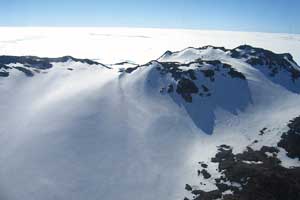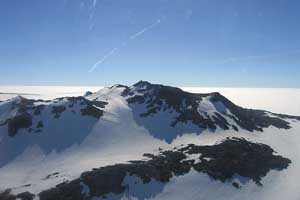Dauphas validates ancient rocks’ origin, gives hope for finding clues to earliest life
By Steve KoppesNews Office
 The rock samples studied by Nicolas Dauphas came from Iron Mountain of the Issua region (above) of southwest Greenland.  | |
Experiments led by the University’s Nicolas Dauphas have validated some remarkable rocks from Greenland as the potential site for the earliest evidence of life on Earth.
“The samples that I have studied are extremely controversial,” said Dauphas, Assistant Professor in Geophysical Sciences and the College and an associate at the Field Museum in Chicago.
Some scientists have claimed that these samples of banded iron formation rocks from Greenland’s Akilia Island contain traces of life that push back the biological record of life on earth to 3.85 billion years ago. Others, however, dismiss the claim.
They argue that the rocks originally existed in a molten state, a condition unsuitable for the preservation of evidence for life.
“My results show unambiguously that the rocks are sediments deposited at the bottom of an ocean,” Dauphas said. “This is an important result. It puts the search for life on the early Earth on firm foundations.”
Dauphas announced his findings in the Dec. 17, 2004 issue of the journal Science. His co-authors are Meenakshi Wadhwa and Philip Janney of Chicago’s Field Museum, Andrew Davis of the University, and Mark van Zuilen and Bernard Marty of France’s Centre de Recherches Petrographiques et Geochimiques.
The oldest-known microfossils, extremely small fossils which come from Australia and which are themselves disputed, are more than 3.4 billion years old. Scientists have now turned their attention to Greenland for evidence of even older biological activity.
The controversy over the Greenland rocks stemmed from changes they underwent over the long history of the Earth. “During burial they were subjected to high pressure and temperatures, which completely modified the chemistry and mineralogy of the rocks,” Dauphas said. Consequently, scientists found it difficult to determine whether the rocks were igneous (those that had cooled from a once-molten state) or sedimentary (eroded and deposited by wind or water). Only sedimentary rocks would be able to preserve evidence of life.
That question was finally answered by a state-of-the-art mass spectrometer in Wadhwa’s laboratory at the Field Museum. The spectrometer was among the resources that led Dauphas, Wadhwa and their Science co-authors to form the Chicago Center for Cosmochemistry earlier this year.
The center is a collaboration between the University, the Field Museum and Argonne National Laboratory to study the elements and their many atomic variations in meteorites and other materials from Earth and space. Dauphas used the spectrometer to measure with high precision the subtle atomic variations in the composition of iron, called isotopes, preserved in rocks on the southwest coast of Greenland and Akilia Island. The variations in these isotopes told them what type of process formed the rock, Wadhwa said.
“From the standpoint of these isotopes, there’s very convincing evidence that these rocks cannot be igneous,” she said.
Unlike igneous rocks, the Greenland samples contained a considerable range of isotopic variation in iron isotopes, said Davis, Director of the Chicago Center for Cosmochemistry and Senior Scientist in the Enrico Fermi Institute. “All igneous rocks on the Earth have pretty much the same iron isotopic composition, so it was really a simple test.”
The question that remains is whether the Greenland rocks actually contain evidence for early life. Circumstantial evidence suggests they do. These ancient rocks have been oxidized, meaning they have chemically reacted with oxygen. But the atmosphere of the early Earth contained much less oxygen than it does today. Where did the oxygen come from?
Photosynthesis, a chemical process signaling the presence of life, might be the answer. It is a question that Dauphas intends to pursue in his new Origins Lab at the University.
“We can’t claim at this stage that there is unequivocal evidence for biological activity four billion years ago,” Davis said. But the Greenland rocks provide the impetus to continue the investigation. “There are more experiments that need to be done,” he added.
![[Chronicle]](/images/sidebar_header_oct06.gif)